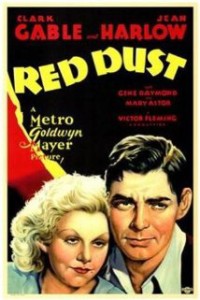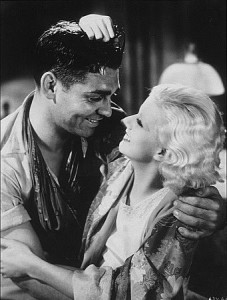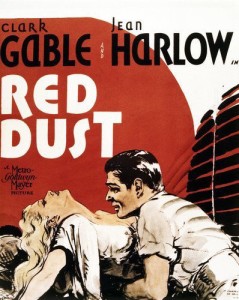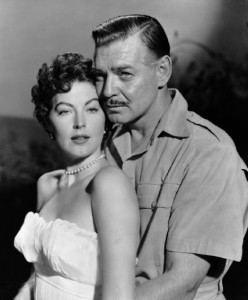Red Dust **** (1932, Clark Gable, Jean Harlow, Gene Raymond, Mary Astor) – Classic Movie Review 2754
‘He treated ’em rough and they loved it…’
Co-producer/director Victor Fleming’s sizzling 1932 MGM romantic adventure comedy movie Red Dust boasts the memorable, sexy pairing of Clark Gable and Jean Harlow in a romantic tussle on a dusty dry Indochina rubber plantation during a monsoon. Mary Astor provides the stylish third side of the jungle triangle as Barbara Willis, soon prepared to dump her husband Gary Willis (Gene Raymond) in favour of the rubber plantation owner (Gable).
Gable plays Dennis Carson, into whose life comes Vantine (Harlow), a floozy on the boat from Saigon, trying to evade the law by laying low on a stopover up-country. Next to arrive are malaria-stricken surveyor Gary Willis (Raymond) and his refined, but sensuous wife Barbara (Astor).
This is an extremely sprightly and highly enjoyable vintage movie, with sharp writing in the expert screenplay by John Lee Mahin, and striking black and white cinematography by Harold Rosson. But it is spurred triumphantly to the winning post by the four alluring star performances. It was Gable’s unshaven lovemaking with a bra-less Harlow here that made him MGM’s most important star.
Also in the intimate cast are Donald Crisp, Forrester Harvey, Willie Fung and Tully Marshall.
Based on a play by Wilson Collison, it was reworked as Congo Maisie in 1940 and remade in Technicolor by John Ford with Gable himself as Mogambo in 1953.
Harlow’s new, real-life husband Paul Bern, a movie business intimate of top MGM producer Irving Thalberg, committed suicide at this time amid rumours that Gable and Harlow were having an off-screen affair.
Thalberg was one of four producers, along with Fleming, Louis B Mayer and Hunt Stromberg.
During filming of the rain barrel sequence, Harlow stood up topless and called out ‘one for the boys in the lab!’ Director Fleming quickly removed the film from the camera to prevent any footage from reaching the black market.
Red Dust is directed by Victor Fleming, runs 83 minutes, is made and released by MGM, is written by John Lee Mahin, based on a play by Wilson Collison, is shot in black and white by Harold Rosson, is produced by Louis B Mayer, Hunt Stromberg, Victor Fleming and Irving Thalberg, is scored by Douglas Shearer and is designed by Cedric Gibbons, with costume design by Adrian (gowns).
It was shot on Stage 6, Metro-Goldwyn-Mayer Studios, 10202 W Washington Blvd, Culver City, California.
© Derek Winnert 2015 Classic Movie Review 2754
Check out more reviews on http://derekwinnert.com






